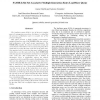Free Online Productivity Tools
i2Speak
i2Symbol
i2OCR
iTex2Img
iWeb2Print
iWeb2Shot
i2Type
iPdf2Split
iPdf2Merge
i2Bopomofo
i2Arabic
i2Style
i2Image
i2PDF
iLatex2Rtf
Sci2ools
98
Voted
IPPS
2006
IEEE
2006
IEEE
SAMIE-LSQ: set-associative multiple-instruction entry load/store queue
The load/store queue (LSQ) is one of the most complex parts of contemporary processors. Its latency is critical for the processor performance and it is usually one of the processor hotspots. This paper presents a highly banked, set-associative, multiple-instruction entry LSQ (SAMIE-LSQ) that achieves high performance with small energy requirements. The SAMIE-LSQ classifies the memory instructions (loads and stores) based on the address to be accessed, and groups those instructions accessing the same cache line in the same entry. Our approach relies on the fact that many in-flight memory instructions access the same cache lines. Each SAMIE-LSQ entry has space for several memory instructions accessing the same cache line. This arrangement has a number of advantages. First, it significantly reduces the address comparison activity needed for memory disambiguation since there are less addresses to be compared. It also reduces the activity in the data TLB, the cache tag and cache data array...
Cache Line | Distributed And Parallel Computing | IPPS 2006 | Memory Instructions | Multiple-instruction Entry Lsq |
| Added | 12 Jun 2010 |
| Updated | 12 Jun 2010 |
| Type | Conference |
| Year | 2006 |
| Where | IPPS |
| Authors | Jaume Abella, Antonio González |
Comments (0)

